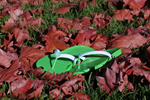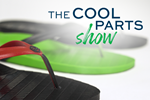In 2020 when Brett Casson launched Retraction Footwear, his business that produces custom flip-flops 3D printed on demand, he had a product design that worked. The company’s original shoe could be 3D printed in just two pieces (strap plus sole, a consolidation that also contributes to the shoes’ sustainability), and the digital design allowed for scaling and adjusting the shoes to fit a customer’s unique feet along with producing them in custom color combinations. These facts alone allowed Retraction to offer many more options and variables to customers than most of us are used to in a shoe purchase.
The original design for Retraction Footwear’s custom shoes. Each flip-flop was printed in just two pieces (strap and sole) which allowed for assembly consolidation, but also revealed the layer lines throughout the contours of the footbed. Photos: Retraction Footwear
But that original flip-flop design wasn’t perfect, and as orders began to grow, Casson started collecting customer feedback — and acting on it. The nimbleness possible through additive manufacturing (AM) has allowed Casson to modify the design of these shoes quickly and affordably, in response to real-time feedback. When the entire manufacturing process is digital, the file becomes the tooling — and the tooling can be easily changed.
The rapid design iteration possible via 3D printing need not stop once the product goes to market. This photo shows just a selection of the different designs Retraction has gone through both before and after its 2020 launch.
In a span of just one year since launch, Retraction Footwear has gone through four major iterations of its product (and many more if you count all the small changes made along the way). The latest version of the shoe looks quite different, with a footbed that is nearly twice as thick as the original (but with an infill pattern that means it doesn’t use twice as much material, Casson notes); a smooth insole that is now printed separately and can be customized with text; and a padded strap that is cushioned with air pockets trapped during the 3D printing process.
The latest iteration of the design. The main part of the footbed is now printed separately which adds some assembly to the process, but the piece can now be printed flat which makes for a smoother surface and allows for incorporating custom text.
“If you were doing this through traditional manufacturing, there’s no way you’d be able to evolve that quickly,” Casson says. “Or at least, not without a huge budget.”
Conventional shoe manufacturers of course change and evolve the designs of their footwear, but this comes with a large investment in tooling and lead time; a new generation of a shoe only appears every so often. But with 3D printing, customer input can lead much more quickly to new iterations of the product. Or even, “Let me fix that for you and send you a new pair,” Casson says.
He expects the design will continue to evolve and change in the future, but Retraction is also working to help customers order the best possible fit from the beginning. Where previously buyers ordered based on their shoe size, Retraction Footwear is now partnering with Xesto, a footwear fitting app for Apple devices that can capture precise measurement of a person’s foot. Though intended to help users select the right size in conventional shoe shopping, the app’s capabilities are a natural complement to 3D printed footwear where the measurements themselves can become the appropriate custom shoe dimensions. While currently customers who choose this option enter their measurements manually while ordering (and shoes can still be purchased in standard sizes), Casson is working toward integrating the app into the website itself, allowing an even more seamless shopping experience for custom-made footwear.
Related Content
Bike Manufacturer Uses Additive Manufacturing to Create Lighter, More Complex, Customized Parts
Titanium bike frame manufacturer Hanglun Technology mixes precision casting with 3D printing to create bikes that offer increased speed and reduced turbulence during long-distance rides, offering a smoother, faster and more efficient cycling experience.
Read More3D Printed Spacer Grids for Nuclear Power: The Cool Parts Show #79
Westinghouse Electric Company is exploring laser powder bed fusion as a means of manufacturing spacer grids, critical parts of the fuel rod assemblies used in pressurized water reactors.
Read MoreAt General Atomics, Do Unmanned Aerial Systems Reveal the Future of Aircraft Manufacturing?
The maker of the Predator and SkyGuardian remote aircraft can implement additive manufacturing more rapidly and widely than the makers of other types of planes. The role of 3D printing in current and future UAS components hints at how far AM can go to save cost and time in aircraft production and design.
Read MoreBeehive Industries Is Going Big on Small-Scale Engines Made Through Additive Manufacturing
Backed by decades of experience in both aviation and additive, the company is now laser-focused on a single goal: developing, proving and scaling production of engines providing 5,000 lbs of thrust or less.
Read MoreRead Next
Retraction Footwear Is the Sustainable Manufacturing Business of the Future
Retraction Footwear offers a new way of buying flip-flops that are made to suit each customer. But the company also represents a new way of thinking about production, in a circular economy loop that encompasses material, design, manufacturing, product and end-of-life.
Read MoreAM Brings Down the Wall Between Manufacturing and Design
In additive manufacturing, design and manufacturing blend together. They can’t be separate if AM is to realize its promise.
Read MoreWhat Do These Flip Flops Say About Manufacturing's Future?: The Cool Parts Show #21
These 3D printed flip-flops are an example of mass customization, but they also hint at manufacturing's more sustainable, circular future. Find out why in this episode of The Cool Parts Show.
Read More

.jpg;width=70;height=70;mode=crop)























